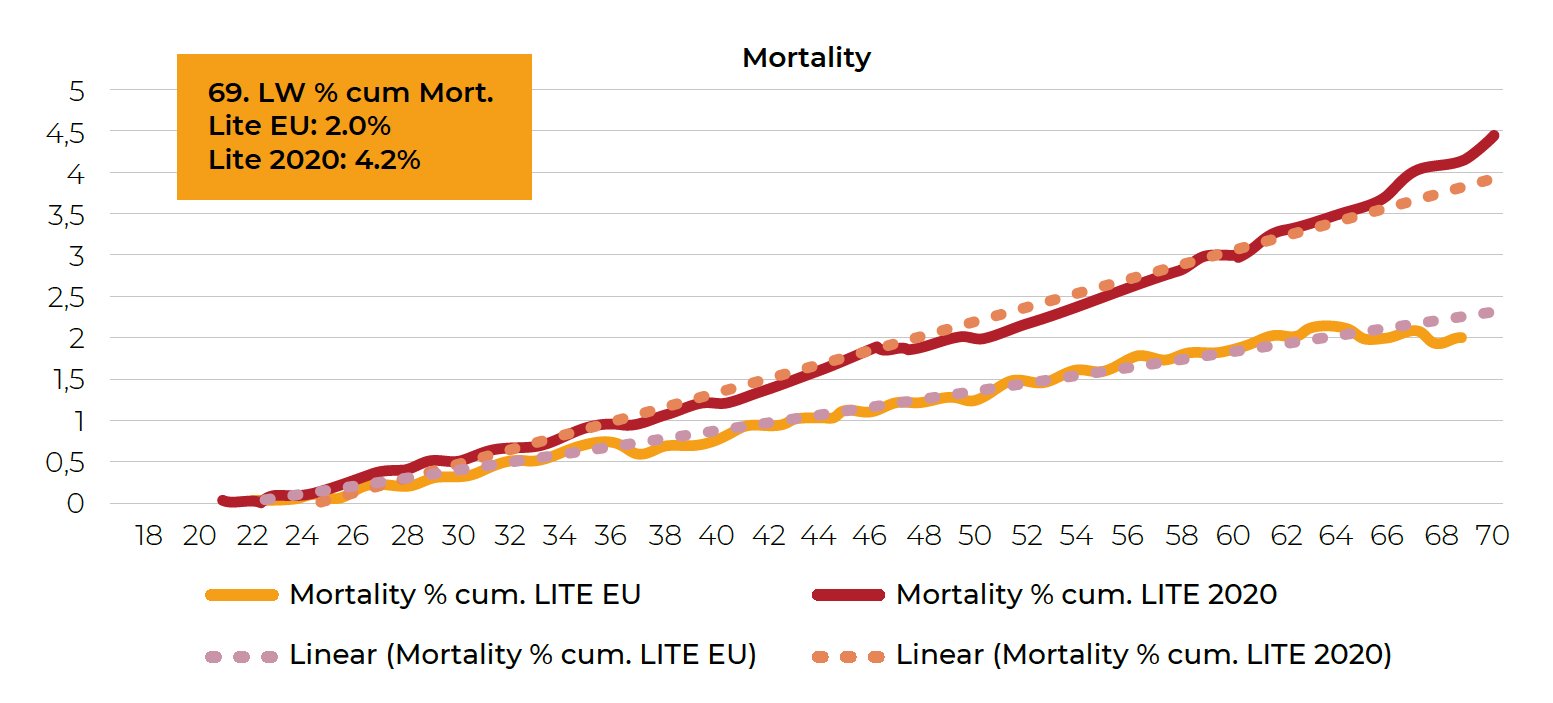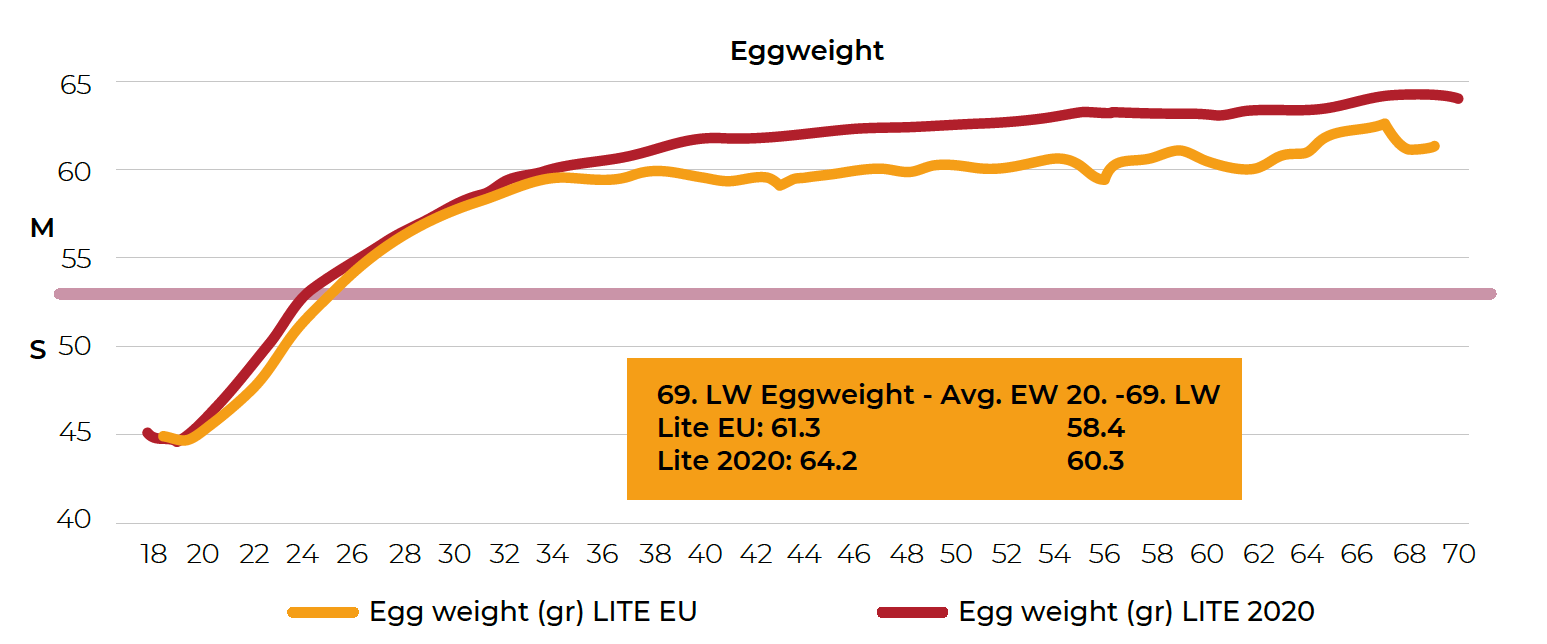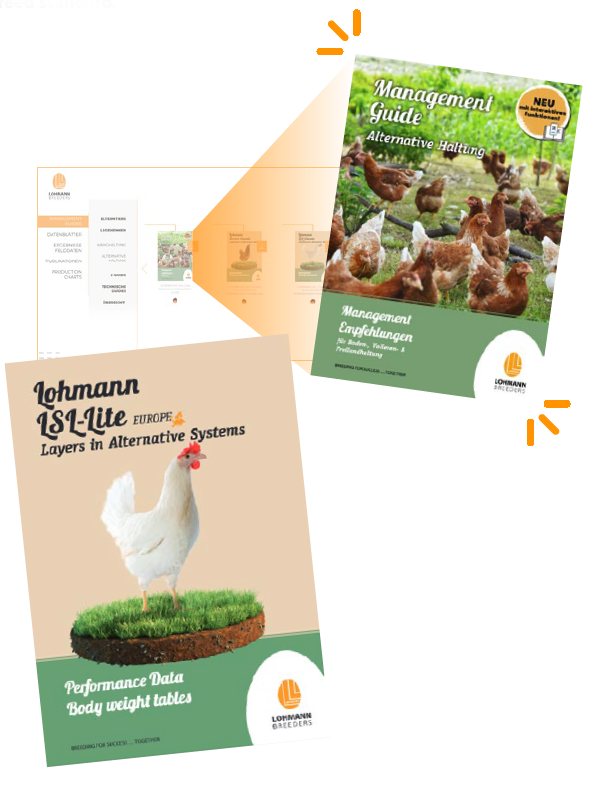The market conditions for shell eggs in some western European countries have changed over the last few years significantly. Especially in Germany and The Netherlands the price pressure from the discounters for the cheapest possible egg make the egg packers
to prefer a medium/small white egg.
The cost price to produce this egg is lower than large white eggs and little lower than a medium sized brown egg. As on the producer side, there is no extra income from large eggs (white eggs), the demand for a hen with as many as possible M eggs increased.
The regular LSL LITE hen, with a cumulative egg size of 61,5 grams at 80 weeks produced ca 35 – 40% large eggs. As there is no extra payment for large eggs, this egg size was too high for the markets in western Eurpope where white eggs are prefered in the Discounter segment.
The main focus for the new hen was put on the following criteria and circumstances.
With these targets, from the existing gene pool of the LSL LITE pure lines, families were identified, which matched these targets in the best way. From those families, the new variety of LSL LITE called “LSL LITE EUROPE” was created and parentstock produced for Germany and The Netherlands.


 Figure 1. Comparison of mortality of LSL LITE EUROPE (orange line) compared to
regular LSL LITE (red line), data provided by Ter Heerdt
Figure 1. Comparison of mortality of LSL LITE EUROPE (orange line) compared to
regular LSL LITE (red line), data provided by Ter Heerdt
As forecasted, the bird has obviously a lower metabolic stress from a smaller egg size and is therefore more robust and resilient against environmental factors. The mortality is reduced by more than 50 % to a level of 2 % at 69 weeks of age for the oldest flock of LSL LITE EUROPE. The lower trend is visible throughout the whole life.

 Figure 2. Comparison of egg weight of LSL LITE EUROPE (orange line)
compared to regular LSL LITE (red line), data provided by Ter Heerdt
Figure 2. Comparison of egg weight of LSL LITE EUROPE (orange line)
compared to regular LSL LITE (red line), data provided by Ter Heerdt

The cost price to produce this egg is lower than large white eggs and little lower than a medium sized brown egg. As on the producer side, there is no extra income from large eggs (white eggs), the demand for a hen with as many as possible M eggs increased.
The regular LSL LITE hen, with a cumulative egg size of 61,5 grams at 80 weeks produced ca 35 – 40% large eggs. As there is no extra payment for large eggs, this egg size was too high for the markets in western Eurpope where white eggs are prefered in the Discounter segment.
Adjustments of LSL Lite
As this situation is sustaining, an adjustment in the LSL LITE was necessary.The main focus for the new hen was put on the following criteria and circumstances.
- Cage free, mainly aviary and free range
- Conventional and organic
- Flat egg weight curve with a reasonable number of S-eggs
- (below 53 gr.)
- Egg size after 60 weeks of age not much over 61-62 grams
- Excellent livability and good robustness, resilience
- Good feather cover without beak treatment
- Good feed conversion with 125-130 gr. feed per egg
With these targets, from the existing gene pool of the LSL LITE pure lines, families were identified, which matched these targets in the best way. From those families, the new variety of LSL LITE called “LSL LITE EUROPE” was created and parentstock produced for Germany and The Netherlands.

Since spring 2021 commercial chicks from this modified variety hatched and now is time to summarize the so far results from flocks now in an age of up to 65 weeks.

Summary of results
Livability
To the current stage, the targets which have been set are fully achieved. Especially the improved livability is very obvious.In Figure 1, the comparison of mortality from the former LSL LITE version with the new LSL LITE EUROPE is very clear (data provided from Ter Heerdt, flocks from The Netherlands and Germany, more than 1 mio birds).
 Figure 1. Comparison of mortality of LSL LITE EUROPE (orange line) compared to
regular LSL LITE (red line), data provided by Ter Heerdt
Figure 1. Comparison of mortality of LSL LITE EUROPE (orange line) compared to
regular LSL LITE (red line), data provided by Ter HeerdtAs forecasted, the bird has obviously a lower metabolic stress from a smaller egg size and is therefore more robust and resilient against environmental factors. The mortality is reduced by more than 50 % to a level of 2 % at 69 weeks of age for the oldest flock of LSL LITE EUROPE. The lower trend is visible throughout the whole life.
To avoid any confusing message about the regular LSL LITE breed: the 4,2 % mortality at 69 weeks of age in this data set is absolutely within the breed standard for the regular LSL LITE and does not reflect at all a “poor” livability of the regular LSL LITE.
Just the new LSL LITE EUROPE is even better but can only be achieved if the smaller egg size is accepted in the market. Of course, the LSL LITE behavior of the hens is reported to be Summary of results excellent calm and not at all nervous.
The “known” advantages of LSL LITE like a good body weight in rearing and a good flexibility in feed intake are with the new hen the same. The feed intake in the lay period is still high enough to achieve a good production, but from the high correlation between egg size and feed intake, the smaller egg size makes a lower feed intake per day compared to the regular LSL LITE before. 3-4 grams lower feed intake per day is observed in most of the flocks.

Does the percentage of small eggs increase compared to the regular LSL LITE?
The lower egg size is already mentioned and explained, but how is the egg size curve with the new hen: does the percentage of small eggs increase compared to the regular LSL LITE?The answer is given in the Figure 2: The early egg size has not changed significantly. The threshold of 53 grams is reached only a few days later and after reaching the 59 grams with 32 weeks, the egg weight curve is very flat and stays long time around 60 grams.
This is the desired egg weight curve for the maximum of M-sized eggs without too many S-eggs and too many L-eggs. The average/cumulative egg weight in the 69. week of age (age of the oldest flock) is 1,9 grams lower compared the year before from the regular LSL LITE.
 Figure 2. Comparison of egg weight of LSL LITE EUROPE (orange line)
compared to regular LSL LITE (red line), data provided by Ter Heerdt
Figure 2. Comparison of egg weight of LSL LITE EUROPE (orange line)
compared to regular LSL LITE (red line), data provided by Ter Heerdt
There may be an effect of a slightly different feed formulation in the more actual data of the LSL LITE EUROPE flocks which also have contributed to this lower egg size. Nevertheless, the flatter curve is obvious and very much desired by the packing stations.
Breed standard
If you look for the breed standard of “LSL LITE EUROPE” you will not find this as a new variety name on our homepage.As the LSL LITE EUROPE is only used in Germany and The Netherlands, the breed standard is visible in the “Management Guide Alternative Housing” in German language.
With scanning the QR code in this text, you can go directly to this breed standard.












